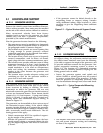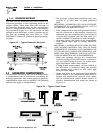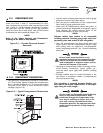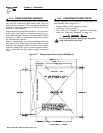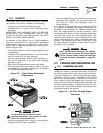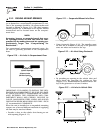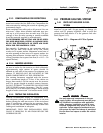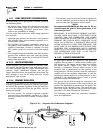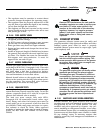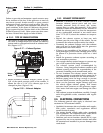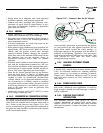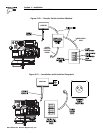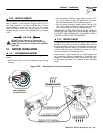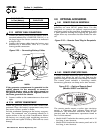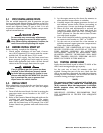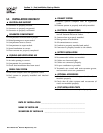
Generac
®
Power Systems, Inc. 27
Section 2 – Installation
IMPACT-36 plus II Recreational Vehicle Generator
• The regulator must be sensitive to venturi throat
pressure changes throughout the operating range.
• The regulator must be properly adjusted so it will
stop the flow of gas when the engine is not running
(no air flow through the carburetor).
• The slightest air flow (and vacuum) in the venturi
throat should move the regulator valve off its seat
and permit gas to flow.
2.4.6 FUEL SUPPLY LINES
• Propane gas lines must be accessible, but protect-
ed against possible damage.
• Do NOT connect electrical wiring to any propane
gas fuel line or run wiring alongside the lines.
• Route gas lines away from hot engine exhausts.
• Retain gas lines with metal clamps that do not have
sharp edges.
• Install an approved length of flexible hose between
the gaseous fuel solenoid valve and rigid fuel sup-
ply lines. The flexible line must be non-metallic,
non-organic and non-conductive. It must be
approved for use with LP gas.
2.4.7 EXCESS FLOW VALVE
Propane gas tanks should have an excess flow valve,
according to NFPA 501C, Paragraph 3-4.4. This valve
and the gas lines must be carefully sized so the valve
will close when a fuel line is severed or broken.
Consult the Natural-LP Gas Association for informa-
tion and limitations of excess flow valves.
Manual shutoff valves on the supply tank and else-
where in the system must be fully open when operat-
ing the generator. The excess flow valve functions
properly only if all valves are fully open.
2.4.8 LEAKAGE TESTS
Do not place the generator into service until the gas
system has been properly tested for leaks. To test the
system, a separate source of 12 volts DC to open the
gaseous fuel solenoid valve is needed.
The leak test must comply fully with NFPA,
Paragraph 318. All connections, hoses, valves, regu-
lators, fitting, and other fuel system parts must be
tested under gas or air pressure of not less than 90
psi (620kPa). while using soap and water or equiva-
lent solution to check for leaks. Other approved
methods of testing for leaks may be used, if appro-
priate. DO NOT USE ANY FLAME TO TEST FOR
LEAKS.
Gaseous fuel lines between the tank and the
secondary regulator are under a positive pres-
sure (about 11 inches water column). Gas
pressure at the outlet side of the secondary
regulator, however, is a negative pressure
(about 1-inch water column) and can draw
flame inside a line or fitting and cause an
explosion.
2.5 EXHAUST SYSTEM
The generator exhaust system must be safely and
properly installed. Only approved mufflers and other
exhaust system parts must be used. A properly
installed exhaust system must be vapor tight, quiet
and completely safe.
Never tee the generator engine exhaust pipe
into the vehicle engine exhaust piping. This
causes excessive back pressure on the genera-
tor engine. Also, water from one engine can
damage the other engine.
The generator engine gives off deadly carbon
monoxide gas through its exhaust system.
This dangerous gas, if breathed in sufficient
concentrations, can cause unconsciousness or
even death. Symptoms of carbon monoxide
poisoning are (a) inability to think coherently,
(b) vomiting, (c) twitching muscles, (d) throb-
bing in temples, (e) dizziness, (f) headache, (g)
weakness and sleepiness. If any of these
symptoms ar experienced, move into fresh air
immediately. If symptoms persist, get medical
attention. Do not operate the generator until
its exhaust system has been inspected and
repaired.
2.5.1 MUFFLERS AND SPARK ARRESTORS
Exhaust mufflers and spark arrestors that Generac
supplies meet code and standard requirements, and
are approved by the U.S. Forest Service. Use only
mufflers and parts approved by Generac. Any per-
son(s) installing an unapproved muffler, or an unap-
proved exhaust system part, or modifying an exhaust
system in any way that might cause a hazard, is liable
for any damage, injury or warranty expense that
might be caused by such unapproved installation or
modification.
◆
!
DANGER
!
DANGER
◆
◆
◆



